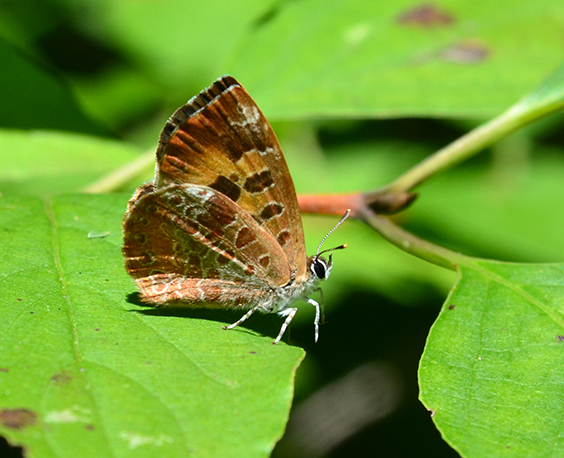Predictable Harvester
By Ranger Steve Mueller, 11/220
Animals have mysterious routines we know little about to keep their bodies and minds fit. From early to late afternoon the Harvester visits selected roosting locations In warm seasons. It is a small butterfly with brown and tan undersides of wings that are visible when it stands on a leaf with wings folded upward over its back. A number of irregular silver lines or circles loop on the wing outlining brown speckles.
The top of wings can be viewed when the butterfly partially opens them. The upper wing has large patches of orange bordered in black. How color patterns aid survival is mostly unknown to me. Colors help with mate or rival recognition. For now the Harvest is selected for the winter.
Observations indicate predictable activity periods. I do not see the Harvester in the roosting area until afternoon and it continues a presence into late afternoon. The butterflies perch on shrub leaves about five feet above the ground along the north side of a forest clearing where sun glistens on leaves. There it stands patiently waiting. Later on a summer day it perches at the east border of the clearing when sun rays brighten leaf landing pads.
Apparently the butterfly has business elsewhere in the morning. Perhaps it travels to speckled alders and ash trees on the floodplain where wooly aphids suck juices from tender stems. Harvesters lay eggs among the white wooly wax covering aphids create and use it to cover their bodies. When the caterpillar hatches, it covers its body with the waxy fluff and begins eating aphids. It is concealed and camouflaged from its predators by the wax and eats peacefully controlling aphid numbers.
The caterpillar develops quickly in a chrysalis in summer months to emerge as an adult butterfly. It overwinters for an extended period in a chrysalis.
I visit the butterfly’s afternoon roosting site daily on walks. When a second one flies near, it darts toward it. It could possibly be a suitable mate or rival male.
Last year there were three broods. Spring, summer, and fall broods were present. The spring brood flew May 31 through June 21. The summer brood flew from July 19 through August and the fall brood began in August and overlapped with the summer brood. Harvesters were present through September 26. This year the spring brood began flight on May 31 and was only noticed until June 6. A long gap occurred until the summer (or fall?) brood began on Aug 5. That brood continues at this writing in late August.
The Harvester is the only predatory caterpillar found in the United States and that behavior aids rapid development. Others are vegetarians and mature more slowly. Every species has something uniquely special.
Keep in mind we open Ody Brook Nature Sanctuary to others and our mission is “biodiversity enhancement”. Wild Ones are welcome to walk the trails. A neighbor assisting with habitat management was opening parts of the Old Fallow Field near the powerline in September. He was removing trees to creating more area for herbaceous plants. Near the powerline he saw a Bald Eagle on the ground feeding on something. The eagle looked three-feet tall to him. I saw a Black-throated Green Warbler feeding on insects at the creek midmonth.

Plants and animals abound. I added a new plant species to the sanctuary list this fall. How I missed it previous years baffles me. Several Bottle Gentians (Gentian andrewsii) are present. We have 329 plant species listed and more await listing. Come enjoy and learn about biodiversity enhancement. The sanctuary is closed to walking the east half from October 1 through December 31, but welcome on the Big Field Succession loops, the west floodplain, and Pond Loop during that time. We saw a Green Heron at the Ponds during summer and into fall.
Natural history questions or topic suggestions can be directed to Ranger Steve (Mueller) at [email protected]– Ody Brook Nature Sanctuary, 13010 Northland Dr. Cedar Springs, MI 49319 or call 616-696-1753.
Written for WORC, Nov 2020

